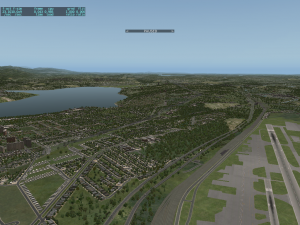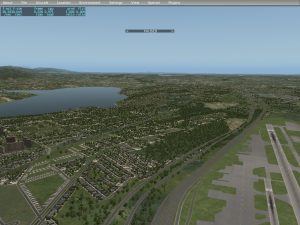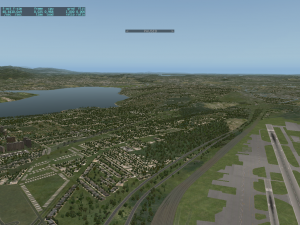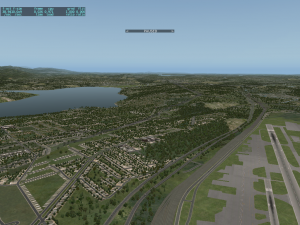ppjoy users on Windows have been experiencing a crash on startup; this was a bug in X-Plane 10.10/10.11, induced by particular virtual HID devices that only ppjoy could make. I found the problem and it will be fixed in 10.20.
In the meantime, if you need to use ppjoy and want to work around the problem, set your hat switches to discrete directions, not analog. (X-Plane can’t use an analog hatswitch anyway; most people have this because it is a ppjoy default.)
As a side rant to ppjoy users: I was a bit horrified with the process of installing ppjoy. ppjoy is an unsigned driver so I had to turn off driver signing in Windows. ppjoy is also, as far as I can tell, not hosted anywhere official. So I had to install an unsigned driver off of a file locker onto my Windows machine with the safeties off.
To be clear, I do not think that this is the author’s fault. He is making freeware, and the only thing that would remedy these problems is money. I do not and cannot expect him to give up not only his time (to code) but also pay to solve the distribution problems of official hosting and buying a signing certificate.
Still, the process of taking off all of the safeties to put random third party binary software on my Windows box was unnerving and not something I would ever do as an end-user.
As far as I know, the ppjoy crash and the PS3 controller crash are the only two known regression bugs* with joystick hardware, and they’ll both be fixed in 10.20. (Linux users, needing to edit udev rules to use hardware is not something that we consider to be a bug – see this post.)
When will 10.20 go final? Real soon now. Plugin authors, if you aren’t already running on 10.20 betas, you should have been doing that weeks ago.
* Regression bug means: it used to work in 10.05 and stopped working in 10.10 when we rewrote the joystick code.
It’s been a slow week – I’m sick, Alex was sick, Chris is sick, Chris’s wife is sick, my wife is sick, Chris’s daughter is sick, my son is sick…basically all of New England has bubonic plague. Skype meetings sound like a 19th century sanitarium for TB patients. But we are making progress on 10.20 betas. What’s still left?
- There are a handful of new 10.20 bugs that I still hope to resolve before we go final: sound problems, Intel GPU compatibility, etc.
- The installer needs to be made 64-bit aware.
- There are a handful of authoring bugs that were present in 10.11. I may push these off to a 10.21 bug fix patch, so that we can get 10.20 out the door sooner.
Users: please stop asking your favorite third party developers when they will release a 64-bit version of their add-ons. The devs are really stuck until we finalize 10.20. If they release an add-on before 10.20 goes final and then something comes up during beta, the dev is stuck fire-drilling a quick fix of the add-on.
Thanks to everyone who offered help WRT Intel GPUs. I have been in contact with the Intel driver team and we have a potential work-around for the HD4000 GPUs crashing. We do not yet have a fix or work-around for Gen-4 (GS45 chipset) GPUs crashing.
We also do not have a work-around for black sky with Intel HD GPUs and HDR mode, but honestly if you have an Intel GPU, I recommend keeping HDR off for frame-rate reasons. (I only have the HD3000 though – it’s possible that the GPUs on the new Ivy Bridge chipsets are faster. We’ll know once the shader-compiler issue is fixed.)
EDIT: Let me be more clear: we do not need any more volunteers! Thank you to everyone who helped. If you have this configuration, please just check the release notes in the next beta and test when the bugs are reported fixed.
If you are a Windows 7 X-Plane user with:
- An Ivy Bridge Intel CPU (in other words, one of those really nice shiny new ones)
- In a desktop machine (so that you can remove your GPU) and
You have an appetite for misery- You can spend an hour or two running test builds over the next day or so
Please email me (ben at x-plane dot com). I need to gather diagnostics on problems with the Intel HD4000 motherboard graphics, but I only have the previous-gen chipset.
This series of exchanges happens to me way too often:
User: X-Plane crashes when I change the flap setting.
Me: Which airplane does this happen on.
User: Any airplane.
Me: (Tries one of the default airplanes. Crash does not happen.) I could not reproduce this!
This has happened to me over and over again. Invariably, when told that a bug is reproducible with “any” materials, it turns out that the bug requires something specific, like a particular airplane or scenery pack.
Bugs that occur with any materials are far less common than bugs that happen to particular airplanes or scenery because bugs that happen all of the time are more frequent and easier to spot and fix.
If we ask you which airplane or scenery pack a bug happened on, or ask you for reproduction materials, it means that either:
- We already tried the bug on our own airplane or scenery pack and it didn’t happen or:
- We think it’s very likely that the bug is specific to something in the airplane, based on how the code works or
- We haven’t gotten any other reports of the bug, making it unlikely that it happens for all airplanes.
Now here’s the thing: if you have seen a bug, you saw it with a particular airplane or scenery pack. When you report the bug, just tell us which materials you used!
(One exception: if you’re using a custom airplane, try one of the defaults first – that’ll be the first thing we ask you anyway.)
I’ll end this rant with a philosophical thought: you shouldn’t report a bug as happening with any airplane unless you have tried it with all airplanes.
EDIT: when this article was originally written, the 2.1.2 plugin SDK was not available, which caused a lot of confusion. The new SDK is now posted, and the building instructions are completely updated.
Beta 11 is out and this hopefully has the final set of SDK changes for 64-bit plugins. Besides a bunch of other fixes (see the release notes), here’s the rough state of plugins:
- 32-bit plugins should just work. If you have a plugin that worked in X-Plane 10.11 but is broken in 10.20, please report a bug – even if it’s not your own plugin! I really want to hear about any of these cases.
- 64-bit plugins should just work; if they don’t, it may be due to programmer error, so please only report a 64-bit plugin problem if you wrote the plugin.
- A new SDK (2.1.2) is cut with real frameworks for the Mac; Sandy and I spent a pile of time working on this, but I need to update the wiki instructions. Docs coming in the next 48 hours I hope.
- Name and shame is gone for linking, so the logs should be clean. If your plugin crashes, you still get named and shamed.
I had a chance to work this week on the Blender 2.49 scripts; here’s a quick update on the status of the scripts and what the next steps are.
Blender 2.49 for Internal Scenery Development
Relatively early in X-Plane 10 development, we picked Blender 2.49 for our scenery development environment. We did this for a few reasons:
- The two artists doing scenery (Alex for cities, Tom for airports) both used Blender 2.49 as their primary 3-d tool.
- There was already a completely functional OBJ exporter (Jonathan’s XPlane2Blender scripts, version 3.09) that produced highly optimized OBJ output.
At the time, some developers were already migrating to Blender 2.5, but Ondrej’s exporter was only partly written. Since we didn’t need any Blender 2.5 features and schedule time was of primary importance, we decided to stick with 2.49 (to avoid the delay of our artists learning a new environment and the delay of having to wait for or develop for ourselves a complete and fully optimized exporter).
The result is that I augmented Jonathan’s scripts to:
- Fully support X-Plane 10 OBJ extensions like instancing, the new GLOBAL attributes and draped geometry.
- Export some of the other v10 data types (autogen, facades, roads). Exporting non-OBJ stuff is really complicated, and the rules to use Blender to make the right meta data are not trivial.
Other Scripts
There are other variants of the scripts floating around: both Ondrej and Ben Russell added partial manipulator export to the 3.09 scripts to help aircraft authors. Ondrej has also created a new branch (the “3.20” scripts) that target Blender 2.50 and newer.
There’s one technical point tot note about Blender that might not be obvious: for all practical purposes. Blender 2.4x and Blender 2.5x might as well be completely different programs! They have totally different scripting interfaces and they don’t even use compatible versions of the Python language. Supporting Blender 2.5x is a from-scratch effort and the scripts are totally unrelated to anything you can use on Blender 2.49.
There is no way to use my Blender 2.49 scripts on Blender 2.5; this is just a decision that the Blender developers made – they created a major fork in the Blender world. So when you read about Blender 2.49 vs Blender 2.50, consider that difference to be as major as Blender vs AC3D or Blender vs 3DS.
Recent Work
This week I had time to integrate both Ben and Ondrej’s manipulator export code into my 2.49 scripts, and I also added the remaining missing OBJ8 commands that are useful for aircraft developers. This means that my scripts are now more or less ready for aircraft use as well as scenery use, and they provide a forward path for Blender 2.49 users who use either Jonathan, Ondrej, or Ben’s scripts. This brings me closer to my goal: making a complete set of 2.49 scripts, current to X-Plane 10.
I have a few more loose ends to tie up, but I am hoping to get the scripts pushed to github for Jonathan (and anyone else who wants them) in the next week. There is still a lot of documentation to add.
I’ve been quiet on the blog both because I was out sick for a few days but also because Sandy and I have been bashing pretty heavily on plugins, trying to determine the best way to prevent plugins from conflicting with each other. The way 32-bit plugins link on OS X/Linux allows one plugin to interfere with another one’s code, which causes support problems in-field. We are looking for any way we can to minimize this for 64-bit plugins.
The short of it is this:
- Name & shame is probably not going to work for DLL linkage. (It will work if you crash!)
- Beta 11 should ship with a new XPLM implementation.
- You should not be shipping 64-bit plugins now. You should expect to retest your plugins against the next beta, and possibly even recompile your 64-bit Mac plugin
I cannot emphasize this enough: it’s not over until it’s over. Just because 64-bit plugins appear to be working does not mean that we have worked out all of the bugs and won’t be making radical changes. Once we are out of beta, things should be very stable, but during beta, this is our only time to get things right.
The last plugin ABI lasted over a decade, so it’s important that we get 64-bit right.
X-Plane 10.20 beta 10 is out, and it features a new XPLM with two new features that help plugin authors detect problems with their plugins; I am jokingly calling it “name and shame” because the new code lists the particular name of the plugin that failed. This will help plugin authors figure out which plugin failed in a multi-plugin environment and help users report bugs to the right third party developer.
- If a Linux or Mac 64-bit plugin incorrectly links against a number of common libraries, the plugin manager will log this on plugin load. This will help authors detect linker setting errors and prevent a recurrence of the plugin conflicts that are quite common for 32-bit plugins. (We do not log these problems with 32-bit plugins because they are very common; in fact, the sample templates for the SDK had the linker set up incorrectly until recently, so fixing these problems is “new” for most authors.)
- If a crash is cause by a plugin (and thus not auto-reported to LR) we log the name of the plugin that crashed.
To this second point, your plugin is charged with the crash if ones of its callbacks was running during the crash. This includes calls in X-Plane code due to your plugin. For example if you call XPLMDrawObject with a bad object pointer and the sim crashes, your plugin gets dinged.
This beta (10.20 beta 10) is the beta to test! If you have a 64-bit plugin, go test it against this new beta to see how well it really works!
I have blogged before about the importance of not shipping products that target beta builds of X-Plane, and the importance of waiting to the end of beta for file formats to settle down.
This also applies to the library! While we are in beta, objects in the library may be renamed or disappear in ways that could break your scenery.
So if you are making custom scenery that uses our library, you have two options:
- Ignore the beta; develop against the last stable release (10.11) and use that library, which we will continue to support.
- Use the beta, but don’t release yet, and be prepared for objects to come and go.
In other words, if your custom scenery works in 10.11 but fails in 10.20, please file a bug – we screwed up.
But if your custom scenery works in one 10.20 beta but not another 10.20 beta, don’t use 10.20 beta objects yet – they’re not fully cooked!
X-Plane 10.20 beta 9 is out and (hopefully) fixes missing library paths. Alex and I spent a good chunk of yesterday trying to clean up the tools that generate the autogen library, but it is a very complicated problem, as indicated by the 4786 distinct entries in the library.
Beta 8 and 9 introduce a change in how the rendering settings work; my suspicion is that users seeing a framerate drop in the new betas are seeing the effects of the intermediate rendering settings acting differently; the minimum and maximum for the settings should produce nearly identical results.
I’m not going to try to explain how the settings used to work – the actual results were extremely convoluted due to quirks in the engine. This change is one of several we want to make to both improve how the settings work (from a usability standpoint) and improve the look of the autogen at lower settings.
- The “objects” popup controls the amount of autogen and 3-d stuff in general. Besides adding more autogen, it adds more detail to the autogen as it appears and can even add more detail to custom scenery. (This behavior isn’t new.) In particular, if you use an a complex library element like an “AGP” scene (e.g. the control tower or FAA building) the amount of detail of that mini-scene will increase with the objects setting. The goal here is to have the objects slider control the amount of 3-d.
- The “forests” popup now strictly controls the density of all vegetation in the sim. This includes both the natural forests (.for files for DSF nerds) and the vegetation that is part of the autogen (e.g. the trees that Alex puts down on the lawns of houses). Lower forest settings tend to prioritize the rural forests over autogen trees to save framerate.
- The distance to which 3-d is drawn is controlled by “world detail distance” – this is how far anything 3-d is drawn out to. Finally with this change, this affects the forests as well as the autogen and the roads – everything runs to the same distance.
A few tuning tips:
- If you are running 32-bits, turn “world detail distance” down by at least one notch; having a shorter distance for 3-d will allow the sim to save some memory.
- If you run with full autogen, moderate forests, and highest world detail distance, you may now need to turn forests up and world detail distance down to create the equivalent of what you used to see. In older betas, the forest setting modified world detail distance in some very strange ways.
Our eventual goal is to keep the autogen base footprints even when the object count is very low; the footprints of the autogen contain views of the building tops, allowing for the equivalent of ‘orthophotos only’ for users with very low rendering capabilities. This will help avoid the ‘sea of green’ effect on lower settings. (The behavior now, where whole city blocks disappear) will eventually go away, to be replaced by the “footprint” with roofs of the city block when 3-d is turned down.
These pictures illustrate the effect of world detail distance. Note that the ground images attached to the buildings are still present even as the buildings begin to disappear with lower settings. The last picture shows the autogen with most 3-d buildings stripped away to reveal the ground tiles underneath.




As we keep working on the autogen system we’ll get more and better ground textures in place, more and better ground tiles on the autogen, and yet more buildings; the result should be a reasonably seamless urban experience at a range of rendering settings.
Some cities are “over-green” in their underlying data in the DSF – this happens when the source land class is difficult to ‘fit’ into the grid system efficiently. (Typically a little bit of vegetation or water area affects zoning and ‘greenifies’ a large area.) We will have to address this problem in DSF tile recuts. (In other words, zoning errors are a failure of accuracy compared to the source data, to be recut; adding more autogen improves plausibility by providing a wider variety of “stuff”.)



